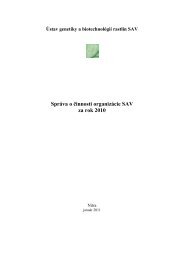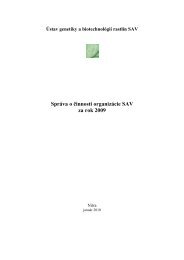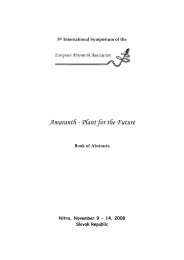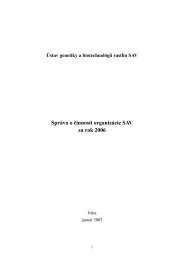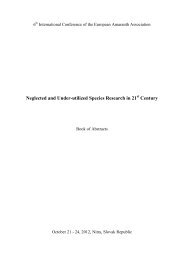annual meeting of esna - pribina.savba.sk - SAV
annual meeting of esna - pribina.savba.sk - SAV
annual meeting of esna - pribina.savba.sk - SAV
You also want an ePaper? Increase the reach of your titles
YUMPU automatically turns print PDFs into web optimized ePapers that Google loves.
Nitrogen deficiency detection and fertiliser variable rate application in<br />
cereals using remote sensing technology<br />
Jana Galambošová, Vladimír Rataj, Matej Zemko<br />
Department <strong>of</strong> Machines and Production Systems, Slovak University <strong>of</strong> Agriculture in Nitra,<br />
Tr. A. Hlinku 2, 94976 Nitra , Slovak Republic<br />
Nitrogen deficiency in cereals is characterized by leaf chlorosis, reduced net assimilation and<br />
relative growth rates, lower leaf area, phytomass and grain yield. Over-application can lead to<br />
the lodging <strong>of</strong> the crop and negative environmental impact, e.g. leaching or diffuse pollution<br />
<strong>of</strong> excess nitrogen. As Nitrogen in crops varies, there is need to apply Nitrogen as soon as the<br />
level <strong>of</strong> deficiency was estimated. Remote sensing technology uses the information on<br />
spectral reflectance <strong>of</strong> crop. Data obtained are highly correlated with crop parameters and<br />
enable to determine the level <strong>of</strong> nitrogen deficiency. Benefit <strong>of</strong> this technology is, that the<br />
information can be gathered and used quickly. When combining this information with<br />
information on position (x, y), the crop requirements can be met site specific.<br />
Due to their availability the use <strong>of</strong> remote sensing sensors is most spread in Europe. These<br />
are mounted on machinery and scan the crop. The information is evaluated and based on crop,<br />
particular variety and growth stage the Nitrogen dose can be applied within one machine pass,<br />
or later. As the results showed, this Nitrogen management technology brings benefits in two<br />
areas:<br />
a) the amount <strong>of</strong> Nitrogen applied may be reduced without a negative effect on yield,<br />
b) the spatial redistribution <strong>of</strong> Nitrogen doses targets the site specific Nitrogen requirements<br />
<strong>of</strong> crop. When using these sensors, the variability <strong>of</strong> applied doses was significant, what has<br />
high potential advantages in terms <strong>of</strong> environment protection.<br />
Acknowledgement: This paper was prepared in the frame <strong>of</strong> research project funded from the<br />
European Union under the title: ITEPAg: Application <strong>of</strong> information technologies to increase<br />
the environmental and economical efficiency <strong>of</strong> production agro-system, ITSM 26220220014.<br />
79



